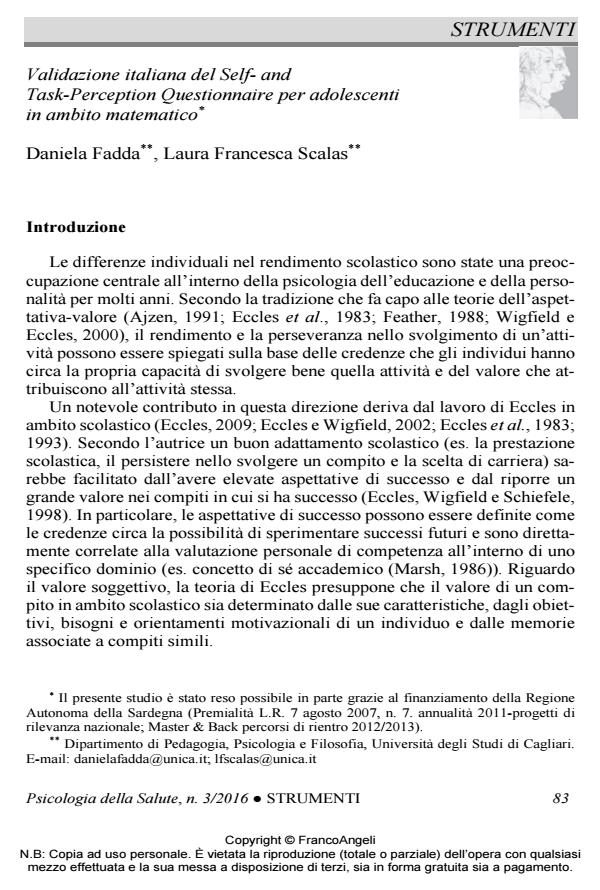Italian validation of the Il Self ‒ and Task ‒ Perception Questionnaire for adolescents in mathematics
Journal title PSICOLOGIA DELLA SALUTE
Author/s Daniela Fadda, Laura Francesca Scalas
Publishing Year 2016 Issue 2016/3
Language Italian Pages 19 P. 83-101 File size 255 KB
DOI 10.3280/PDS2016-003005
DOI is like a bar code for intellectual property: to have more infomation
click here
Below, you can see the article first page
If you want to buy this article in PDF format, you can do it, following the instructions to buy download credits

FrancoAngeli is member of Publishers International Linking Association, Inc (PILA), a not-for-profit association which run the CrossRef service enabling links to and from online scholarly content.
Within the expectancy-value theory framework, the present study provides support for the Italian validation of the Il Self ‒ and Task ‒ Perception Questionnaire for adolescents (STPQ). This instrument, developed by Eccles and colleagues, measures expectancy, subjective task values and perceived difficulty in a specific academic domain. The STPQ consists of 19 items on a 6-point response scale; it shows adequate psychometric proprieties and the ability to predict subsequent performance and career decisions of students. In the present study, we examined motivation toward mathematics in a sample of 440 students (232 males and 208 females), attending the final year of high school. Confirmatory factor analyses were performed to provide support for the six first order factorial structure of the instrument (ability/expectancy, intrinsic/interest value, attainment value/importance, extrinsic/utility value, task difficulty, required effort), which resulted invariant over gender. According with previous international studies, the authors found also a second-order factorial structure, where five of the six first order factors are aggregated in two higher-order factors: subjective task value, and perceived task difficulty. Moreover, this study supported construct and predictive validity of the instrument. Finally, the STPQ could be considered a valid and reliable instrument to measure expectancy, value and task difficulty toward math for high school students.
Keywords: Expectancy-value, mathematics, questionnaire validation, confirmatory factor analysis
Daniela Fadda, Laura Francesca Scalas, Validazione italiana del Self- and Task-Perception Questionnaire per adolescenti in ambito matematico in "PSICOLOGIA DELLA SALUTE" 3/2016, pp 83-101, DOI: 10.3280/PDS2016-003005